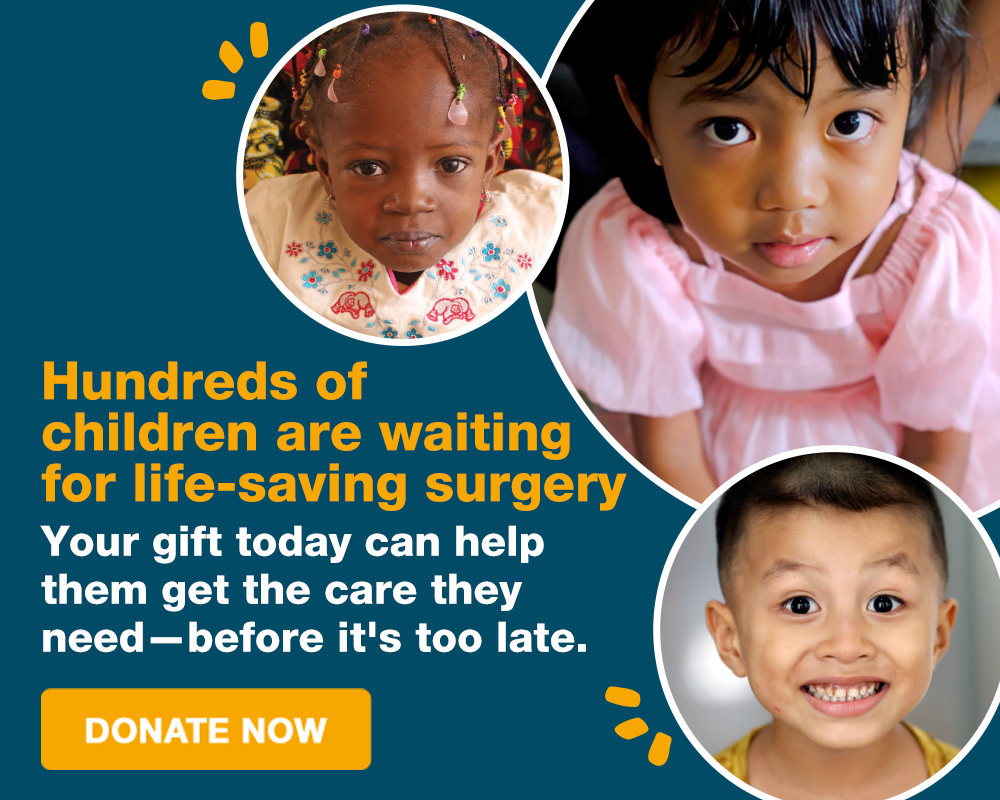By Martin Bischoff
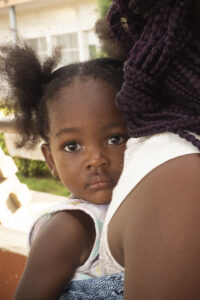 Three days in Lomé, Togo with United Surgeon’s for Children’s (USFC) pediatric surgical mission was one of the most eye-opening experiences of my life. The mission included two French neurosurgeons, Philippe Valenti and Jean-David Werthel, who graciously volunteered their time to operate on 12 children at the Centre Hospitalier Universitaire – Sylvanus Olympio (CHU-SO), the largest hospital in Togo with some 1,200 employees. The 12 children were suffering from separation of the brachial plexus, a network of nerves extending from the spine through the shoulder, arms and hands. During difficult births, these nerves can become separated from the spine, leading to partial or total paralysis of the arm and hand. With surgery, the nerves can be reattached to the spine and allow for full use of the limb, immensely increasing the child’s quality of life. The surgery is, however, highly technical and requires specialized knowledge not widely available in Africa.
Three days in Lomé, Togo with United Surgeon’s for Children’s (USFC) pediatric surgical mission was one of the most eye-opening experiences of my life. The mission included two French neurosurgeons, Philippe Valenti and Jean-David Werthel, who graciously volunteered their time to operate on 12 children at the Centre Hospitalier Universitaire – Sylvanus Olympio (CHU-SO), the largest hospital in Togo with some 1,200 employees. The 12 children were suffering from separation of the brachial plexus, a network of nerves extending from the spine through the shoulder, arms and hands. During difficult births, these nerves can become separated from the spine, leading to partial or total paralysis of the arm and hand. With surgery, the nerves can be reattached to the spine and allow for full use of the limb, immensely increasing the child’s quality of life. The surgery is, however, highly technical and requires specialized knowledge not widely available in Africa.
The medical team also included Gilles Dumenil and Aline Perret, an anesthesiologist and specialist in hospital /surgical hygiene respectively. Aline’s mission to help and teach how to keep rooms, surgical equipment, and patient’s skin sterile amid abundant dirt and dust would be overwhelming to anyone with less dedication. The child in the photo with the cast from his head down his arm is named Marvelos. He is one of the children healed during the mission. The joy I saw in his and other parents’ eyes when they knew their children would be healed was as heart-warming as it gets, and the medical team’s engagement was beyond inspiring.
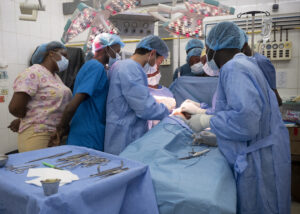 People come to CHU-SO from across Togo to get treatment. Traveling back and forth from their homes is impossible for reasons of distance and cost, so there are people “camping” all around the hospital grounds until their loved ones can be released. This scene was unimaginable before seeing it with my own eyes, and creates significant challenges for the hospital’s administration, which has made cooking, sleeping and sanitary facilities available to its many, many “campers”. I was graced with a guided tour by the hospital’s Director, Yawo Apélété Agbobli, a courageous, joyous military officer, whose leadership and dedication were evident when he described the challenges he and his teams confront every day. He was also optimistic that the hospital would continue to improve its facilities and practices.
People come to CHU-SO from across Togo to get treatment. Traveling back and forth from their homes is impossible for reasons of distance and cost, so there are people “camping” all around the hospital grounds until their loved ones can be released. This scene was unimaginable before seeing it with my own eyes, and creates significant challenges for the hospital’s administration, which has made cooking, sleeping and sanitary facilities available to its many, many “campers”. I was graced with a guided tour by the hospital’s Director, Yawo Apélété Agbobli, a courageous, joyous military officer, whose leadership and dedication were evident when he described the challenges he and his teams confront every day. He was also optimistic that the hospital would continue to improve its facilities and practices.
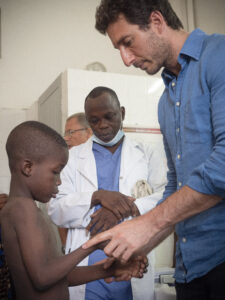 The French team welcomed pediatric orthopedic surgery graduate students from Togo and Mali to attend the procedures and learn to perform it themselves, assuring even more babies and children will benefit in the future. USFC is closely tied to CHU-SO, not only thanks to USFC’s surgical missions but also given investments in the hospital’s wash stations, medical equipment, renovation of its pediatric burn unit and more. Given the prevalence of exposed flames and boiling liquids, childhood burns are an unfortunate reality. Visiting the pediatric burn unit was heart wrenching to say the least. Investing in training and infrastructure to have long-lasting impact is fundamental to USFC’s philosophy.
The French team welcomed pediatric orthopedic surgery graduate students from Togo and Mali to attend the procedures and learn to perform it themselves, assuring even more babies and children will benefit in the future. USFC is closely tied to CHU-SO, not only thanks to USFC’s surgical missions but also given investments in the hospital’s wash stations, medical equipment, renovation of its pediatric burn unit and more. Given the prevalence of exposed flames and boiling liquids, childhood burns are an unfortunate reality. Visiting the pediatric burn unit was heart wrenching to say the least. Investing in training and infrastructure to have long-lasting impact is fundamental to USFC’s philosophy.
It is worth mentioning that CHU-SO obstetricians and (more often) midwives perform 1,200-1,500 births per month in its maternity ward, a volume unheard of in western hospitals. For reference, a typical French maternity birth around 3,000 babies per year, according to one of my knowledgeable colleagues. The resource requirements to birth more than a baby an hour 24/7/365 would be a challenge for the best equipped maternity wards. For CHU-SO, it is a struggle that is met with the determination to respond as well as possible, given a very difficult context, where pitocin and epidurals are non-existent
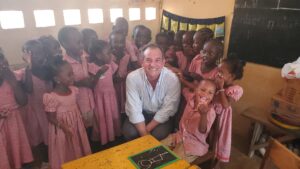 The second day of my trip more light-hearted as we visited the Gbonvie 2 elementary school attended by some 350 children, all dressed in matching uniforms – pink for the littlest kids and beige for the older ones. Their warm welcome, bright eyes, and evident intelligence reminded me again that children are innocent and full of potential no matter the context into which they are born. Thanks to resources made available by USFC, “student ambassadors” are trained in the areas of reproductive and menstrual health, personal and clothing hygiene, nutrition, non-violence, and domestic accident and drug and alcohol avoidance. These ambassadors bring their messages to other students, creating a network effect that will be felt for generations. Gbonvie 2 is one of 16 schools and 20,000 Togolais children supported by USFC under the slogan “ma santé, mon école” (my health, my school). The legacy of this support benefits the children themselves, their families, neighborhoods, and all of Togo.During my visit, other meetings were held with representatives of the Agence Française de Développement (AFD) and the World Health Organization, which work hand-in-hand with NGO’s to address pressing health and infrastructure problems in Togo and around the world.
The second day of my trip more light-hearted as we visited the Gbonvie 2 elementary school attended by some 350 children, all dressed in matching uniforms – pink for the littlest kids and beige for the older ones. Their warm welcome, bright eyes, and evident intelligence reminded me again that children are innocent and full of potential no matter the context into which they are born. Thanks to resources made available by USFC, “student ambassadors” are trained in the areas of reproductive and menstrual health, personal and clothing hygiene, nutrition, non-violence, and domestic accident and drug and alcohol avoidance. These ambassadors bring their messages to other students, creating a network effect that will be felt for generations. Gbonvie 2 is one of 16 schools and 20,000 Togolais children supported by USFC under the slogan “ma santé, mon école” (my health, my school). The legacy of this support benefits the children themselves, their families, neighborhoods, and all of Togo.During my visit, other meetings were held with representatives of the Agence Française de Développement (AFD) and the World Health Organization, which work hand-in-hand with NGO’s to address pressing health and infrastructure problems in Togo and around the world.
On my last day, USFC celebrated its 20-year anniversary in Togo. Some 80 guests, including Augustin Favereau, Ambassador of France to Togo, gathered for a series of speeches, entertainment and testimonials that highlighted the exceptional work done by USFC on behalf of Togolais children for the past two decades. Hearing about how USFC’s surgeon volunteers repaired one of the speaker’s cleft palate and another’s congenital heart defect left no doubt about the positive impact USFC is having on children’s lives. The cocktail reception that followed was full of cheer and goodwill that even a bit of rain could not extinguish!
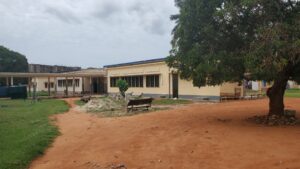 USFC focuses on child health, medical infrastructure, pediatric doctor training and surgery in 30 countries, making it a unique organization whose long-term impact can only be positive. Many thanks again to USFC for inviting me to be part of this unforgettable journey.
USFC focuses on child health, medical infrastructure, pediatric doctor training and surgery in 30 countries, making it a unique organization whose long-term impact can only be positive. Many thanks again to USFC for inviting me to be part of this unforgettable journey.
